IFN600 Research Report: Analyzing GPS Screen Size and Driver Safety
VerifiedAdded on 2021/04/21
|10
|2062
|131
Report
AI Summary
This report, submitted for IFN600, investigates the impact of GPS screen size on driver safety. It begins by outlining the problem statement, focusing on how screen size can be a distraction and lead to inaccurate navigation, vehicle tracking issues and potential dangers. The report then details the approach, including methods for analyzing and comparing literature, and the organization of the literature review. It discusses the scope of the analysis, potential solutions such as larger screens, voice commands, and the implications of these solutions, including the need for drivers to adapt to the technology. The report also highlights future research areas, such as the impact of GPS on driver skills and the development of user-friendly navigation systems. Finally, the report concludes by summarizing the key findings and referencing relevant research on GPS technology, driver behavior, and vehicle safety, emphasizing the importance of understanding the data and user experience to create safer driving conditions. The report emphasizes the importance of considering GPS screen size and its impact on drivers, highlighting the potential for distraction and inaccurate navigation and the need for solutions that enhance safety and usability. It also suggests future research areas to improve the technology and mitigate potential risks.
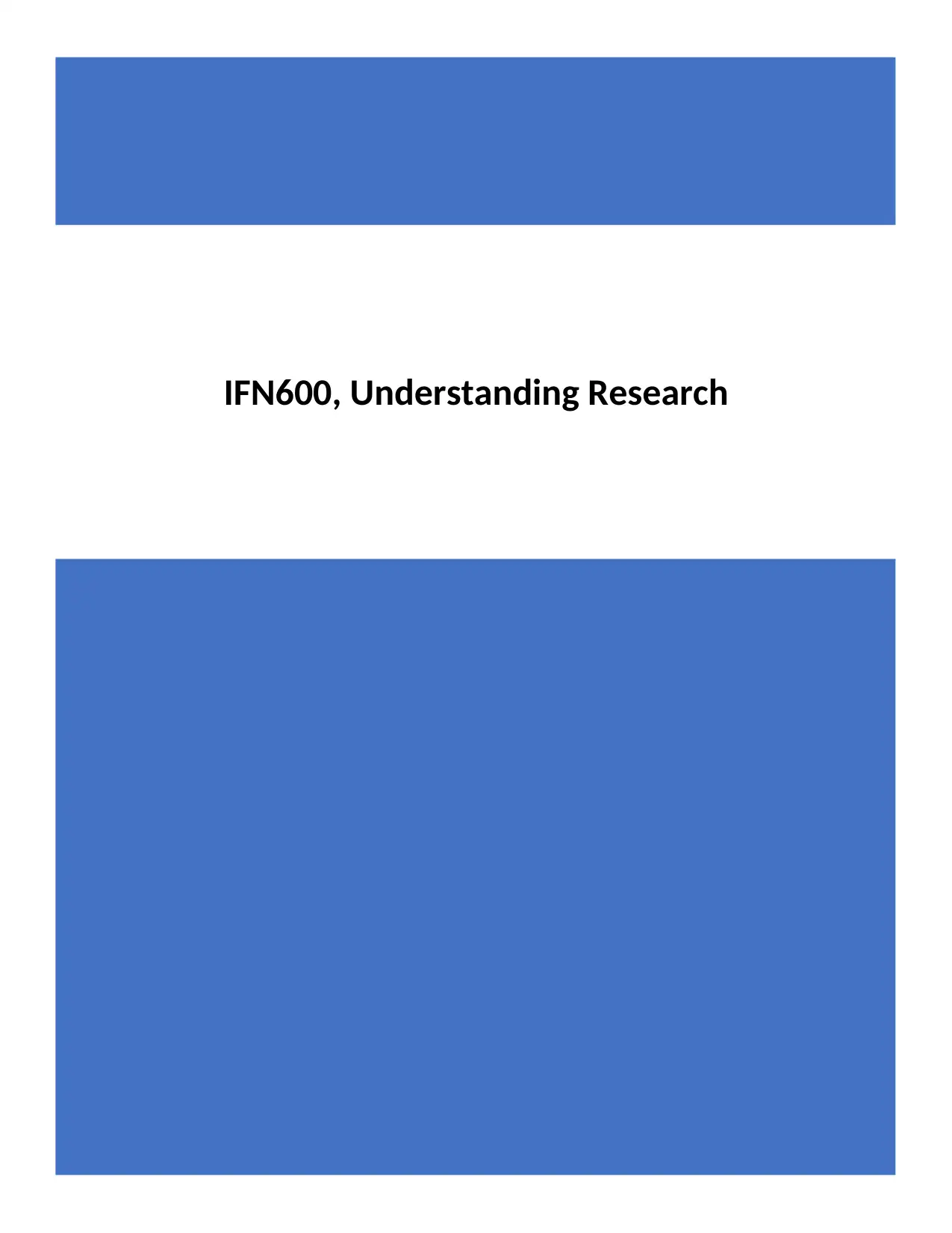
IFN600, Understanding Research
Paraphrase This Document
Need a fresh take? Get an instant paraphrase of this document with our AI Paraphraser
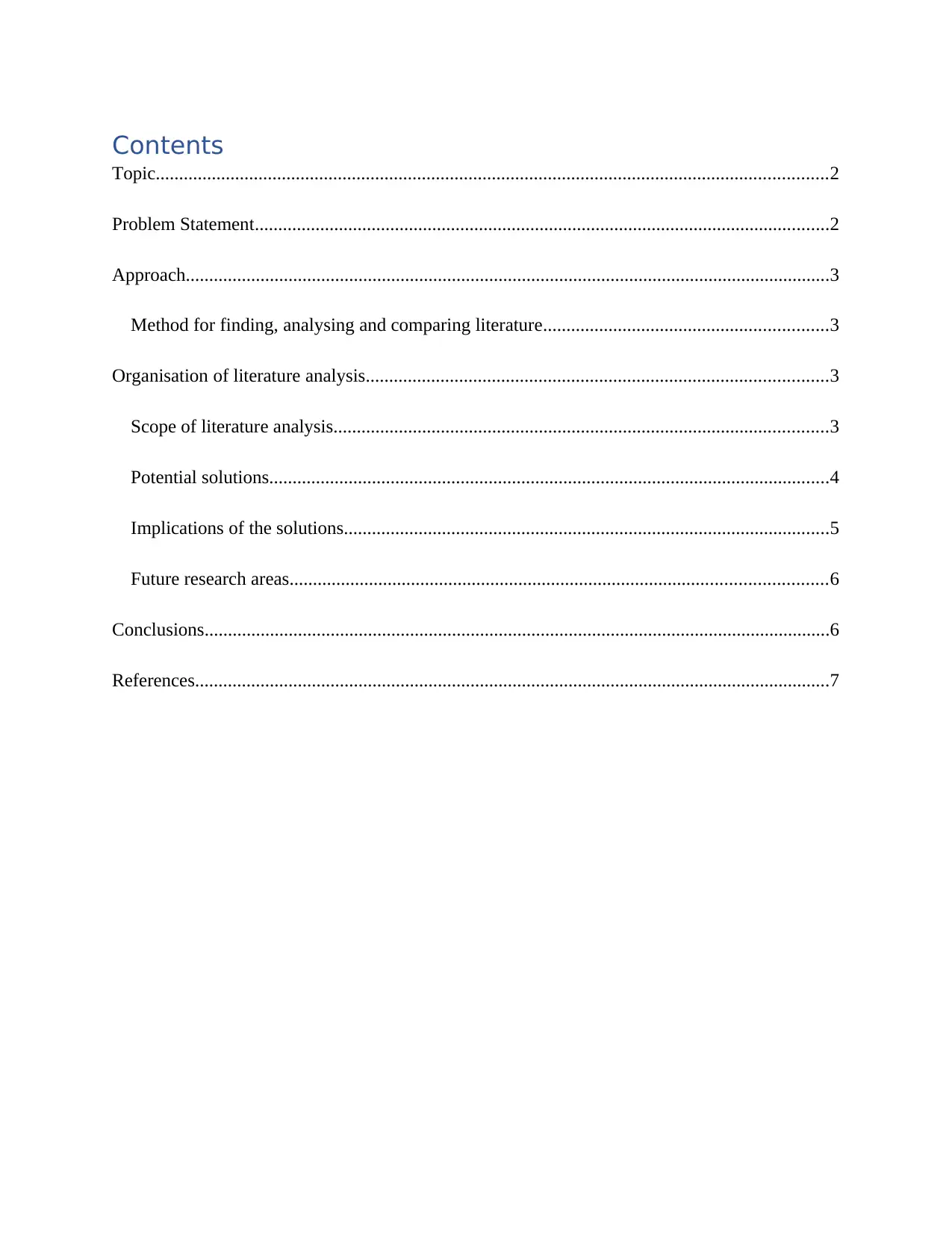
Contents
Topic................................................................................................................................................2
Problem Statement...........................................................................................................................2
Approach..........................................................................................................................................3
Method for finding, analysing and comparing literature.............................................................3
Organisation of literature analysis...................................................................................................3
Scope of literature analysis..........................................................................................................3
Potential solutions........................................................................................................................4
Implications of the solutions........................................................................................................5
Future research areas...................................................................................................................6
Conclusions......................................................................................................................................6
References........................................................................................................................................7
Topic................................................................................................................................................2
Problem Statement...........................................................................................................................2
Approach..........................................................................................................................................3
Method for finding, analysing and comparing literature.............................................................3
Organisation of literature analysis...................................................................................................3
Scope of literature analysis..........................................................................................................3
Potential solutions........................................................................................................................4
Implications of the solutions........................................................................................................5
Future research areas...................................................................................................................6
Conclusions......................................................................................................................................6
References........................................................................................................................................7
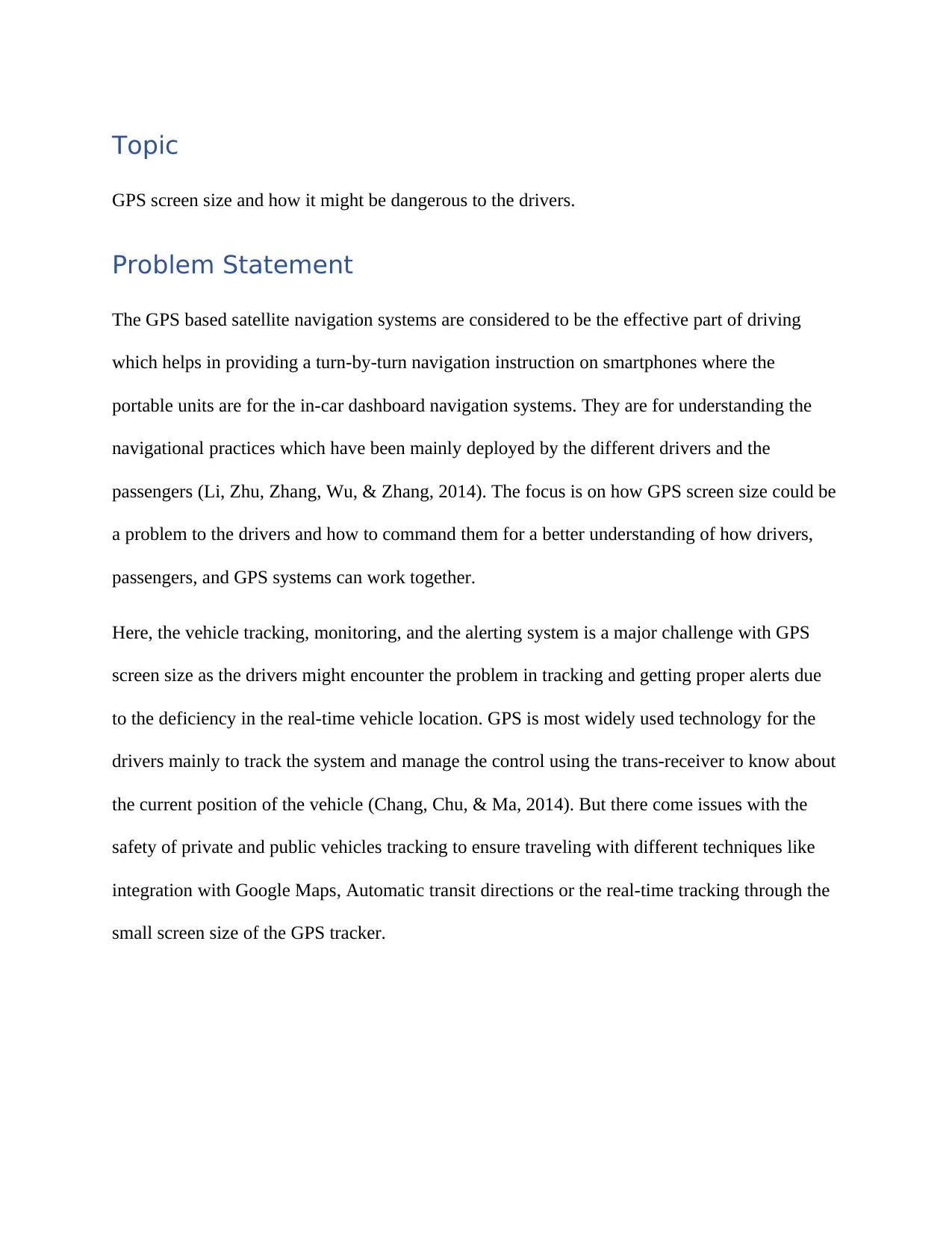
Topic
GPS screen size and how it might be dangerous to the drivers.
Problem Statement
The GPS based satellite navigation systems are considered to be the effective part of driving
which helps in providing a turn-by-turn navigation instruction on smartphones where the
portable units are for the in-car dashboard navigation systems. They are for understanding the
navigational practices which have been mainly deployed by the different drivers and the
passengers (Li, Zhu, Zhang, Wu, & Zhang, 2014). The focus is on how GPS screen size could be
a problem to the drivers and how to command them for a better understanding of how drivers,
passengers, and GPS systems can work together.
Here, the vehicle tracking, monitoring, and the alerting system is a major challenge with GPS
screen size as the drivers might encounter the problem in tracking and getting proper alerts due
to the deficiency in the real-time vehicle location. GPS is most widely used technology for the
drivers mainly to track the system and manage the control using the trans-receiver to know about
the current position of the vehicle (Chang, Chu, & Ma, 2014). But there come issues with the
safety of private and public vehicles tracking to ensure traveling with different techniques like
integration with Google Maps, Automatic transit directions or the real-time tracking through the
small screen size of the GPS tracker.
GPS screen size and how it might be dangerous to the drivers.
Problem Statement
The GPS based satellite navigation systems are considered to be the effective part of driving
which helps in providing a turn-by-turn navigation instruction on smartphones where the
portable units are for the in-car dashboard navigation systems. They are for understanding the
navigational practices which have been mainly deployed by the different drivers and the
passengers (Li, Zhu, Zhang, Wu, & Zhang, 2014). The focus is on how GPS screen size could be
a problem to the drivers and how to command them for a better understanding of how drivers,
passengers, and GPS systems can work together.
Here, the vehicle tracking, monitoring, and the alerting system is a major challenge with GPS
screen size as the drivers might encounter the problem in tracking and getting proper alerts due
to the deficiency in the real-time vehicle location. GPS is most widely used technology for the
drivers mainly to track the system and manage the control using the trans-receiver to know about
the current position of the vehicle (Chang, Chu, & Ma, 2014). But there come issues with the
safety of private and public vehicles tracking to ensure traveling with different techniques like
integration with Google Maps, Automatic transit directions or the real-time tracking through the
small screen size of the GPS tracker.
⊘ This is a preview!⊘
Do you want full access?
Subscribe today to unlock all pages.

Trusted by 1+ million students worldwide
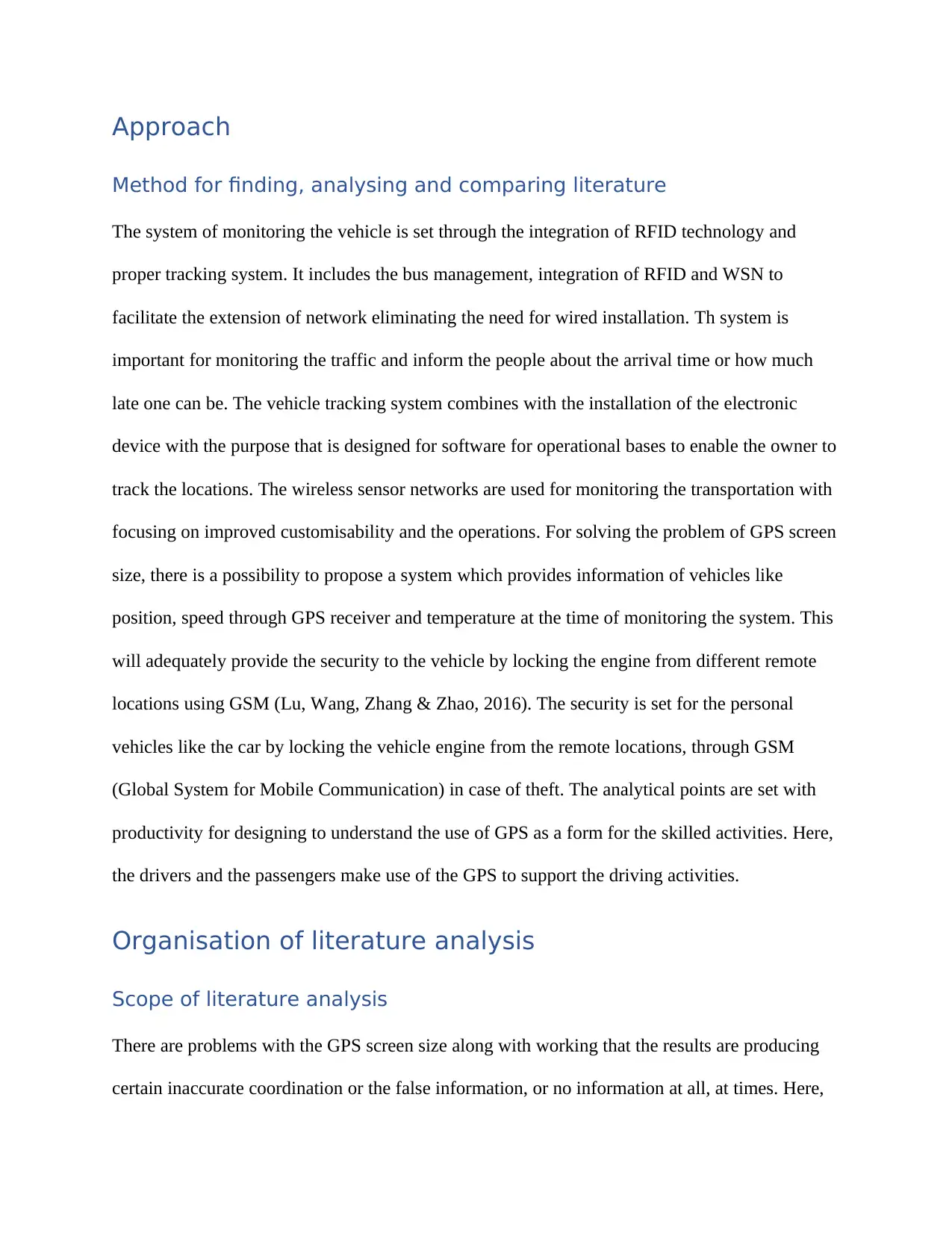
Approach
Method for finding, analysing and comparing literature
The system of monitoring the vehicle is set through the integration of RFID technology and
proper tracking system. It includes the bus management, integration of RFID and WSN to
facilitate the extension of network eliminating the need for wired installation. Th system is
important for monitoring the traffic and inform the people about the arrival time or how much
late one can be. The vehicle tracking system combines with the installation of the electronic
device with the purpose that is designed for software for operational bases to enable the owner to
track the locations. The wireless sensor networks are used for monitoring the transportation with
focusing on improved customisability and the operations. For solving the problem of GPS screen
size, there is a possibility to propose a system which provides information of vehicles like
position, speed through GPS receiver and temperature at the time of monitoring the system. This
will adequately provide the security to the vehicle by locking the engine from different remote
locations using GSM (Lu, Wang, Zhang & Zhao, 2016). The security is set for the personal
vehicles like the car by locking the vehicle engine from the remote locations, through GSM
(Global System for Mobile Communication) in case of theft. The analytical points are set with
productivity for designing to understand the use of GPS as a form for the skilled activities. Here,
the drivers and the passengers make use of the GPS to support the driving activities.
Organisation of literature analysis
Scope of literature analysis
There are problems with the GPS screen size along with working that the results are producing
certain inaccurate coordination or the false information, or no information at all, at times. Here,
Method for finding, analysing and comparing literature
The system of monitoring the vehicle is set through the integration of RFID technology and
proper tracking system. It includes the bus management, integration of RFID and WSN to
facilitate the extension of network eliminating the need for wired installation. Th system is
important for monitoring the traffic and inform the people about the arrival time or how much
late one can be. The vehicle tracking system combines with the installation of the electronic
device with the purpose that is designed for software for operational bases to enable the owner to
track the locations. The wireless sensor networks are used for monitoring the transportation with
focusing on improved customisability and the operations. For solving the problem of GPS screen
size, there is a possibility to propose a system which provides information of vehicles like
position, speed through GPS receiver and temperature at the time of monitoring the system. This
will adequately provide the security to the vehicle by locking the engine from different remote
locations using GSM (Lu, Wang, Zhang & Zhao, 2016). The security is set for the personal
vehicles like the car by locking the vehicle engine from the remote locations, through GSM
(Global System for Mobile Communication) in case of theft. The analytical points are set with
productivity for designing to understand the use of GPS as a form for the skilled activities. Here,
the drivers and the passengers make use of the GPS to support the driving activities.
Organisation of literature analysis
Scope of literature analysis
There are problems with the GPS screen size along with working that the results are producing
certain inaccurate coordination or the false information, or no information at all, at times. Here,
Paraphrase This Document
Need a fresh take? Get an instant paraphrase of this document with our AI Paraphraser
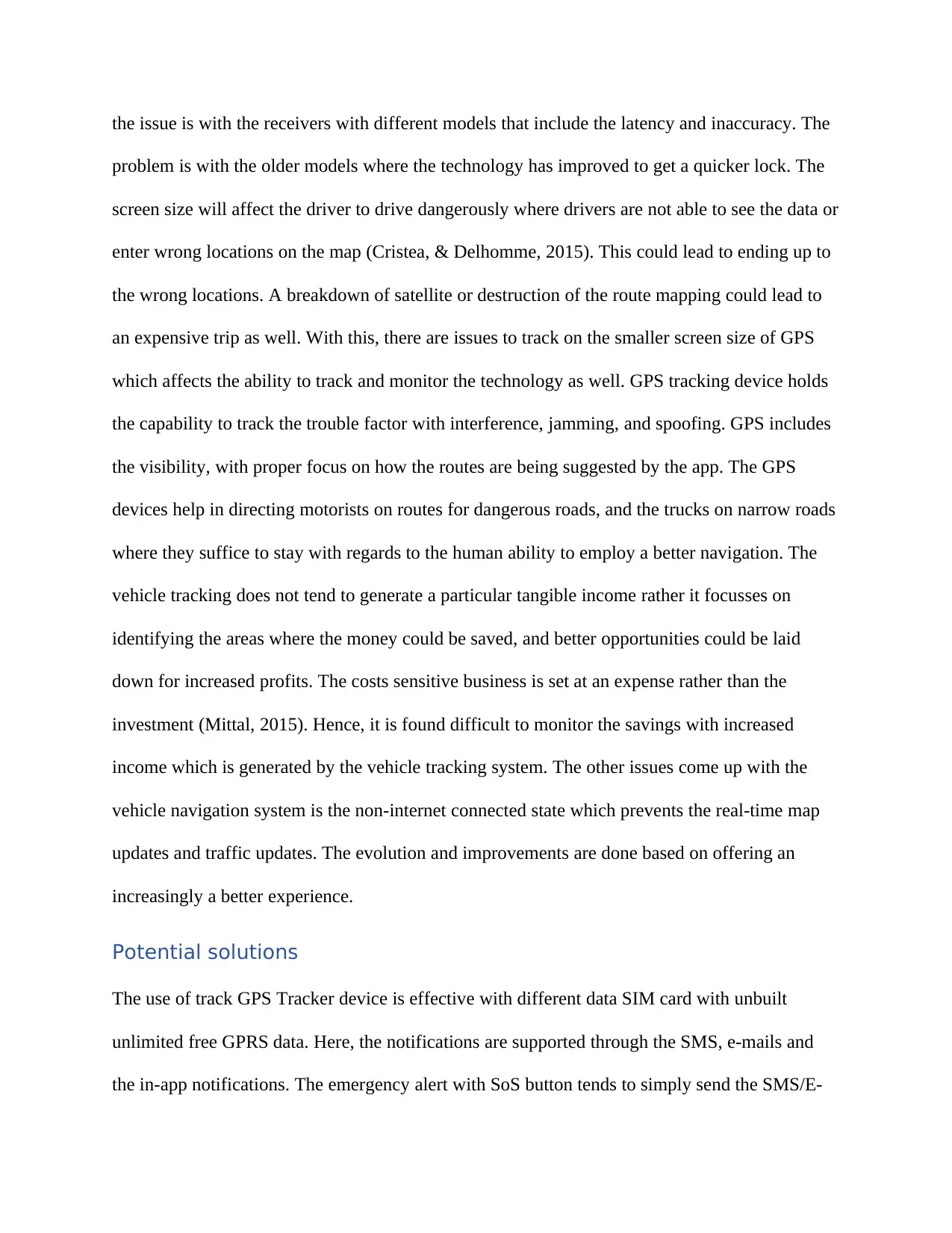
the issue is with the receivers with different models that include the latency and inaccuracy. The
problem is with the older models where the technology has improved to get a quicker lock. The
screen size will affect the driver to drive dangerously where drivers are not able to see the data or
enter wrong locations on the map (Cristea, & Delhomme, 2015). This could lead to ending up to
the wrong locations. A breakdown of satellite or destruction of the route mapping could lead to
an expensive trip as well. With this, there are issues to track on the smaller screen size of GPS
which affects the ability to track and monitor the technology as well. GPS tracking device holds
the capability to track the trouble factor with interference, jamming, and spoofing. GPS includes
the visibility, with proper focus on how the routes are being suggested by the app. The GPS
devices help in directing motorists on routes for dangerous roads, and the trucks on narrow roads
where they suffice to stay with regards to the human ability to employ a better navigation. The
vehicle tracking does not tend to generate a particular tangible income rather it focusses on
identifying the areas where the money could be saved, and better opportunities could be laid
down for increased profits. The costs sensitive business is set at an expense rather than the
investment (Mittal, 2015). Hence, it is found difficult to monitor the savings with increased
income which is generated by the vehicle tracking system. The other issues come up with the
vehicle navigation system is the non-internet connected state which prevents the real-time map
updates and traffic updates. The evolution and improvements are done based on offering an
increasingly a better experience.
Potential solutions
The use of track GPS Tracker device is effective with different data SIM card with unbuilt
unlimited free GPRS data. Here, the notifications are supported through the SMS, e-mails and
the in-app notifications. The emergency alert with SoS button tends to simply send the SMS/E-
problem is with the older models where the technology has improved to get a quicker lock. The
screen size will affect the driver to drive dangerously where drivers are not able to see the data or
enter wrong locations on the map (Cristea, & Delhomme, 2015). This could lead to ending up to
the wrong locations. A breakdown of satellite or destruction of the route mapping could lead to
an expensive trip as well. With this, there are issues to track on the smaller screen size of GPS
which affects the ability to track and monitor the technology as well. GPS tracking device holds
the capability to track the trouble factor with interference, jamming, and spoofing. GPS includes
the visibility, with proper focus on how the routes are being suggested by the app. The GPS
devices help in directing motorists on routes for dangerous roads, and the trucks on narrow roads
where they suffice to stay with regards to the human ability to employ a better navigation. The
vehicle tracking does not tend to generate a particular tangible income rather it focusses on
identifying the areas where the money could be saved, and better opportunities could be laid
down for increased profits. The costs sensitive business is set at an expense rather than the
investment (Mittal, 2015). Hence, it is found difficult to monitor the savings with increased
income which is generated by the vehicle tracking system. The other issues come up with the
vehicle navigation system is the non-internet connected state which prevents the real-time map
updates and traffic updates. The evolution and improvements are done based on offering an
increasingly a better experience.
Potential solutions
The use of track GPS Tracker device is effective with different data SIM card with unbuilt
unlimited free GPRS data. Here, the notifications are supported through the SMS, e-mails and
the in-app notifications. The emergency alert with SoS button tends to simply send the SMS/E-
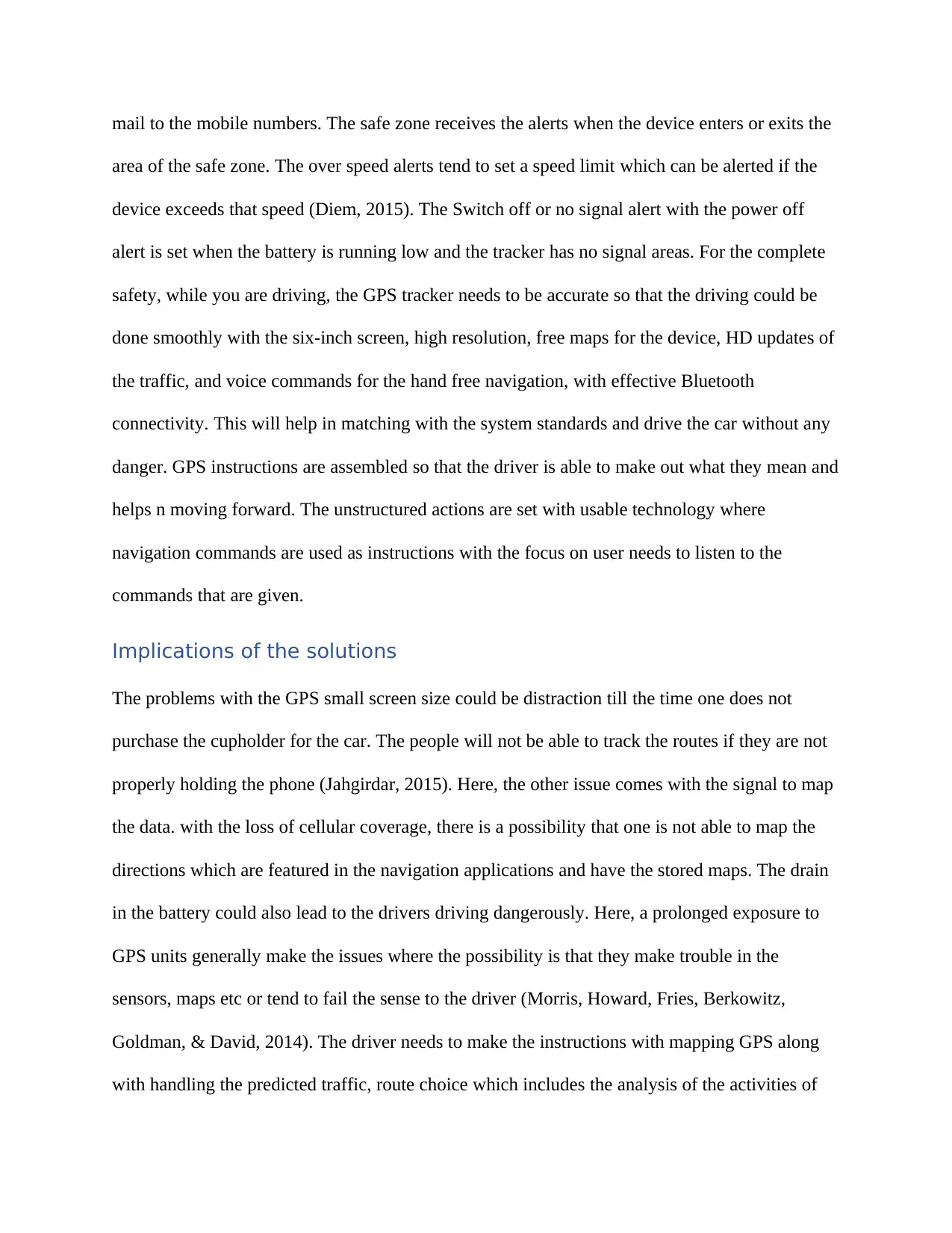
mail to the mobile numbers. The safe zone receives the alerts when the device enters or exits the
area of the safe zone. The over speed alerts tend to set a speed limit which can be alerted if the
device exceeds that speed (Diem, 2015). The Switch off or no signal alert with the power off
alert is set when the battery is running low and the tracker has no signal areas. For the complete
safety, while you are driving, the GPS tracker needs to be accurate so that the driving could be
done smoothly with the six-inch screen, high resolution, free maps for the device, HD updates of
the traffic, and voice commands for the hand free navigation, with effective Bluetooth
connectivity. This will help in matching with the system standards and drive the car without any
danger. GPS instructions are assembled so that the driver is able to make out what they mean and
helps n moving forward. The unstructured actions are set with usable technology where
navigation commands are used as instructions with the focus on user needs to listen to the
commands that are given.
Implications of the solutions
The problems with the GPS small screen size could be distraction till the time one does not
purchase the cupholder for the car. The people will not be able to track the routes if they are not
properly holding the phone (Jahgirdar, 2015). Here, the other issue comes with the signal to map
the data. with the loss of cellular coverage, there is a possibility that one is not able to map the
directions which are featured in the navigation applications and have the stored maps. The drain
in the battery could also lead to the drivers driving dangerously. Here, a prolonged exposure to
GPS units generally make the issues where the possibility is that they make trouble in the
sensors, maps etc or tend to fail the sense to the driver (Morris, Howard, Fries, Berkowitz,
Goldman, & David, 2014). The driver needs to make the instructions with mapping GPS along
with handling the predicted traffic, route choice which includes the analysis of the activities of
area of the safe zone. The over speed alerts tend to set a speed limit which can be alerted if the
device exceeds that speed (Diem, 2015). The Switch off or no signal alert with the power off
alert is set when the battery is running low and the tracker has no signal areas. For the complete
safety, while you are driving, the GPS tracker needs to be accurate so that the driving could be
done smoothly with the six-inch screen, high resolution, free maps for the device, HD updates of
the traffic, and voice commands for the hand free navigation, with effective Bluetooth
connectivity. This will help in matching with the system standards and drive the car without any
danger. GPS instructions are assembled so that the driver is able to make out what they mean and
helps n moving forward. The unstructured actions are set with usable technology where
navigation commands are used as instructions with the focus on user needs to listen to the
commands that are given.
Implications of the solutions
The problems with the GPS small screen size could be distraction till the time one does not
purchase the cupholder for the car. The people will not be able to track the routes if they are not
properly holding the phone (Jahgirdar, 2015). Here, the other issue comes with the signal to map
the data. with the loss of cellular coverage, there is a possibility that one is not able to map the
directions which are featured in the navigation applications and have the stored maps. The drain
in the battery could also lead to the drivers driving dangerously. Here, a prolonged exposure to
GPS units generally make the issues where the possibility is that they make trouble in the
sensors, maps etc or tend to fail the sense to the driver (Morris, Howard, Fries, Berkowitz,
Goldman, & David, 2014). The driver needs to make the instructions with mapping GPS along
with handling the predicted traffic, route choice which includes the analysis of the activities of
⊘ This is a preview!⊘
Do you want full access?
Subscribe today to unlock all pages.

Trusted by 1+ million students worldwide
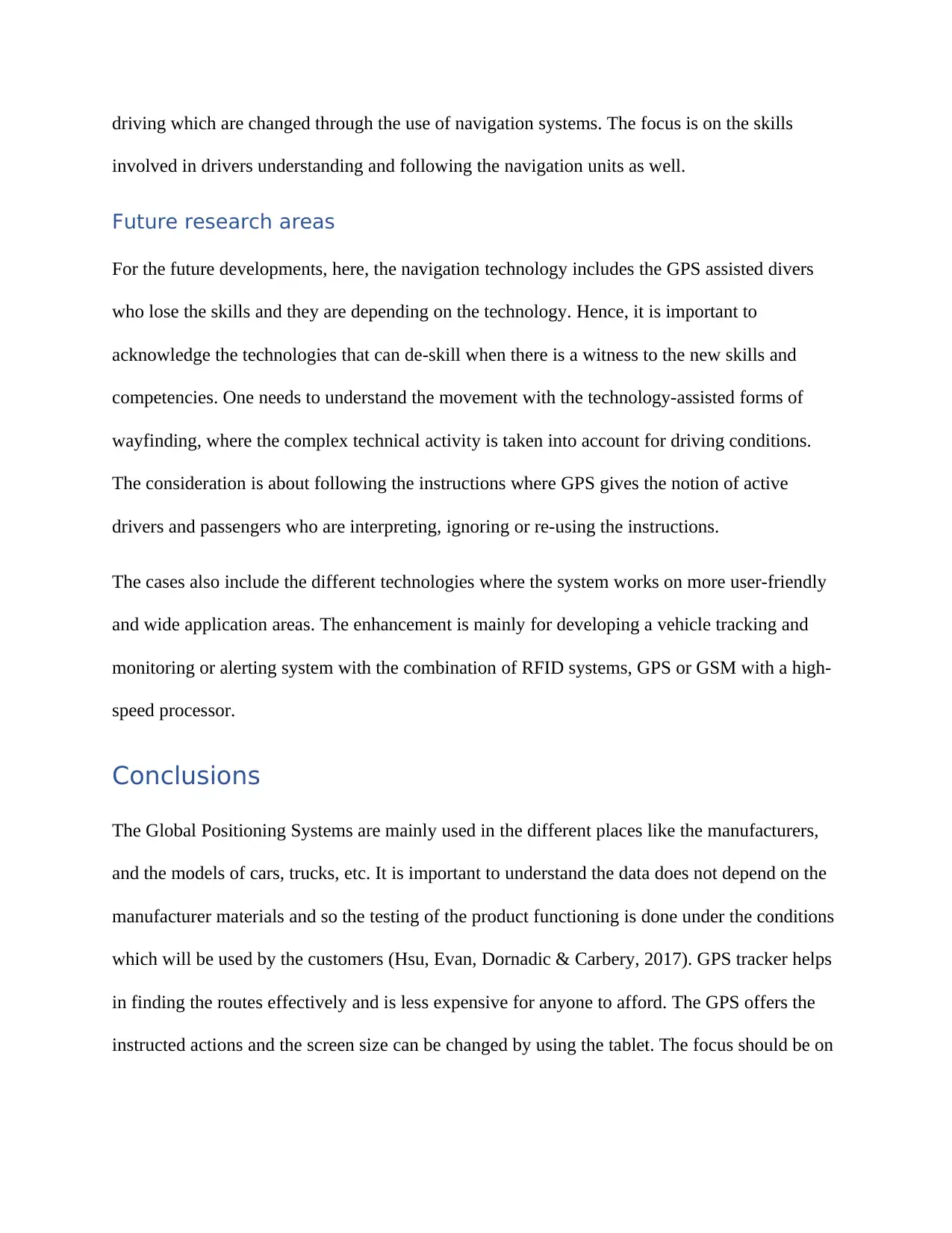
driving which are changed through the use of navigation systems. The focus is on the skills
involved in drivers understanding and following the navigation units as well.
Future research areas
For the future developments, here, the navigation technology includes the GPS assisted divers
who lose the skills and they are depending on the technology. Hence, it is important to
acknowledge the technologies that can de-skill when there is a witness to the new skills and
competencies. One needs to understand the movement with the technology-assisted forms of
wayfinding, where the complex technical activity is taken into account for driving conditions.
The consideration is about following the instructions where GPS gives the notion of active
drivers and passengers who are interpreting, ignoring or re-using the instructions.
The cases also include the different technologies where the system works on more user-friendly
and wide application areas. The enhancement is mainly for developing a vehicle tracking and
monitoring or alerting system with the combination of RFID systems, GPS or GSM with a high-
speed processor.
Conclusions
The Global Positioning Systems are mainly used in the different places like the manufacturers,
and the models of cars, trucks, etc. It is important to understand the data does not depend on the
manufacturer materials and so the testing of the product functioning is done under the conditions
which will be used by the customers (Hsu, Evan, Dornadic & Carbery, 2017). GPS tracker helps
in finding the routes effectively and is less expensive for anyone to afford. The GPS offers the
instructed actions and the screen size can be changed by using the tablet. The focus should be on
involved in drivers understanding and following the navigation units as well.
Future research areas
For the future developments, here, the navigation technology includes the GPS assisted divers
who lose the skills and they are depending on the technology. Hence, it is important to
acknowledge the technologies that can de-skill when there is a witness to the new skills and
competencies. One needs to understand the movement with the technology-assisted forms of
wayfinding, where the complex technical activity is taken into account for driving conditions.
The consideration is about following the instructions where GPS gives the notion of active
drivers and passengers who are interpreting, ignoring or re-using the instructions.
The cases also include the different technologies where the system works on more user-friendly
and wide application areas. The enhancement is mainly for developing a vehicle tracking and
monitoring or alerting system with the combination of RFID systems, GPS or GSM with a high-
speed processor.
Conclusions
The Global Positioning Systems are mainly used in the different places like the manufacturers,
and the models of cars, trucks, etc. It is important to understand the data does not depend on the
manufacturer materials and so the testing of the product functioning is done under the conditions
which will be used by the customers (Hsu, Evan, Dornadic & Carbery, 2017). GPS tracker helps
in finding the routes effectively and is less expensive for anyone to afford. The GPS offers the
instructed actions and the screen size can be changed by using the tablet. The focus should be on
Paraphrase This Document
Need a fresh take? Get an instant paraphrase of this document with our AI Paraphraser

understanding the instructions before driving the car, which will help in easily working on the
awareness of features for materials.
awareness of features for materials.
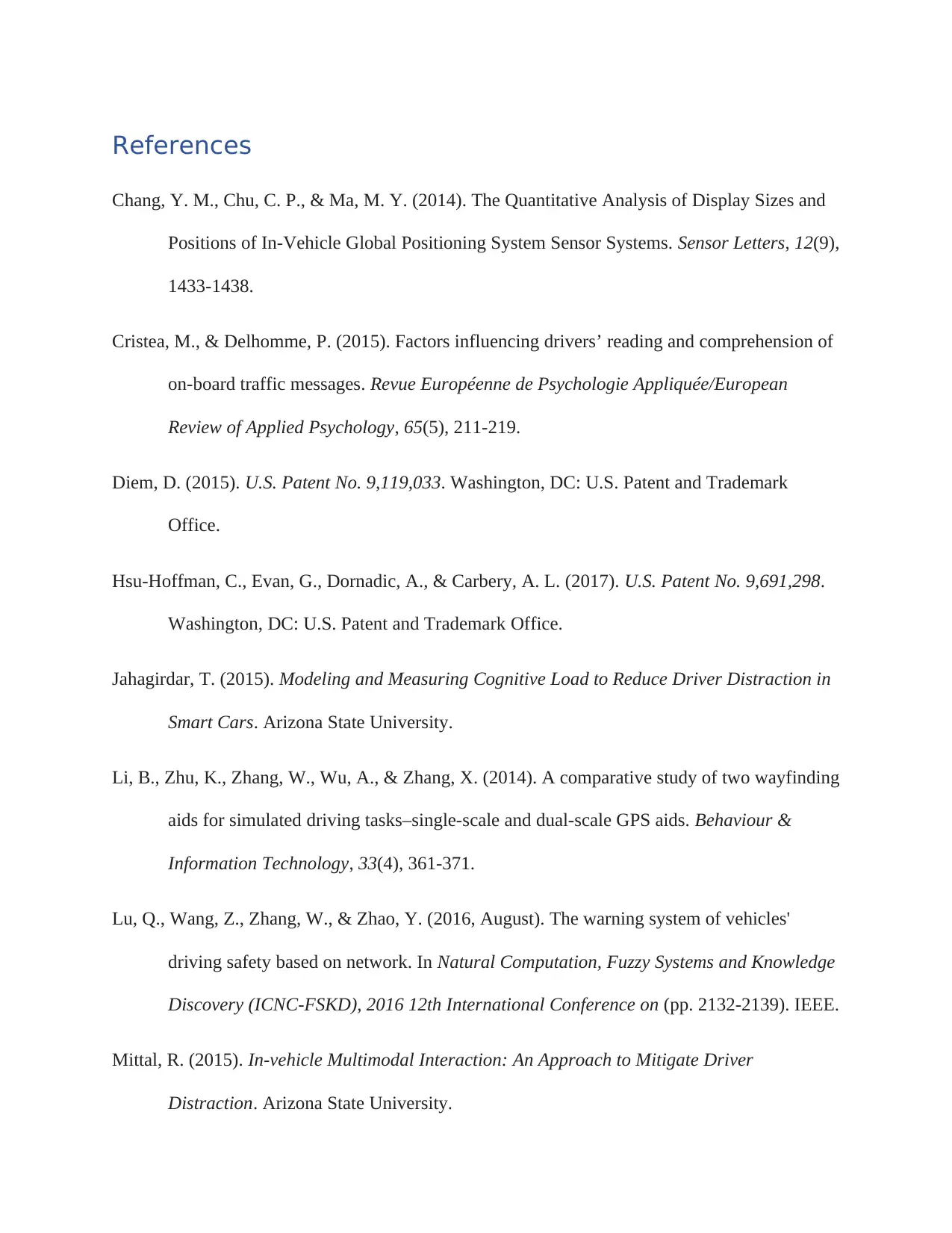
References
Chang, Y. M., Chu, C. P., & Ma, M. Y. (2014). The Quantitative Analysis of Display Sizes and
Positions of In-Vehicle Global Positioning System Sensor Systems. Sensor Letters, 12(9),
1433-1438.
Cristea, M., & Delhomme, P. (2015). Factors influencing drivers’ reading and comprehension of
on-board traffic messages. Revue Européenne de Psychologie Appliquée/European
Review of Applied Psychology, 65(5), 211-219.
Diem, D. (2015). U.S. Patent No. 9,119,033. Washington, DC: U.S. Patent and Trademark
Office.
Hsu-Hoffman, C., Evan, G., Dornadic, A., & Carbery, A. L. (2017). U.S. Patent No. 9,691,298.
Washington, DC: U.S. Patent and Trademark Office.
Jahagirdar, T. (2015). Modeling and Measuring Cognitive Load to Reduce Driver Distraction in
Smart Cars. Arizona State University.
Li, B., Zhu, K., Zhang, W., Wu, A., & Zhang, X. (2014). A comparative study of two wayfinding
aids for simulated driving tasks–single-scale and dual-scale GPS aids. Behaviour &
Information Technology, 33(4), 361-371.
Lu, Q., Wang, Z., Zhang, W., & Zhao, Y. (2016, August). The warning system of vehicles'
driving safety based on network. In Natural Computation, Fuzzy Systems and Knowledge
Discovery (ICNC-FSKD), 2016 12th International Conference on (pp. 2132-2139). IEEE.
Mittal, R. (2015). In-vehicle Multimodal Interaction: An Approach to Mitigate Driver
Distraction. Arizona State University.
Chang, Y. M., Chu, C. P., & Ma, M. Y. (2014). The Quantitative Analysis of Display Sizes and
Positions of In-Vehicle Global Positioning System Sensor Systems. Sensor Letters, 12(9),
1433-1438.
Cristea, M., & Delhomme, P. (2015). Factors influencing drivers’ reading and comprehension of
on-board traffic messages. Revue Européenne de Psychologie Appliquée/European
Review of Applied Psychology, 65(5), 211-219.
Diem, D. (2015). U.S. Patent No. 9,119,033. Washington, DC: U.S. Patent and Trademark
Office.
Hsu-Hoffman, C., Evan, G., Dornadic, A., & Carbery, A. L. (2017). U.S. Patent No. 9,691,298.
Washington, DC: U.S. Patent and Trademark Office.
Jahagirdar, T. (2015). Modeling and Measuring Cognitive Load to Reduce Driver Distraction in
Smart Cars. Arizona State University.
Li, B., Zhu, K., Zhang, W., Wu, A., & Zhang, X. (2014). A comparative study of two wayfinding
aids for simulated driving tasks–single-scale and dual-scale GPS aids. Behaviour &
Information Technology, 33(4), 361-371.
Lu, Q., Wang, Z., Zhang, W., & Zhao, Y. (2016, August). The warning system of vehicles'
driving safety based on network. In Natural Computation, Fuzzy Systems and Knowledge
Discovery (ICNC-FSKD), 2016 12th International Conference on (pp. 2132-2139). IEEE.
Mittal, R. (2015). In-vehicle Multimodal Interaction: An Approach to Mitigate Driver
Distraction. Arizona State University.
⊘ This is a preview!⊘
Do you want full access?
Subscribe today to unlock all pages.

Trusted by 1+ million students worldwide

Morris, J. N., Howard, E. P., Fries, B. E., Berkowitz, R., Goldman, B., & David, D. (2014).
Using the community health assessment to screen for continued driving. Accident
Analysis & Prevention, 63, 104-110.
Using the community health assessment to screen for continued driving. Accident
Analysis & Prevention, 63, 104-110.
1 out of 10
Related Documents
Your All-in-One AI-Powered Toolkit for Academic Success.
+13062052269
info@desklib.com
Available 24*7 on WhatsApp / Email
![[object Object]](/_next/static/media/star-bottom.7253800d.svg)
Unlock your academic potential
Copyright © 2020–2025 A2Z Services. All Rights Reserved. Developed and managed by ZUCOL.



